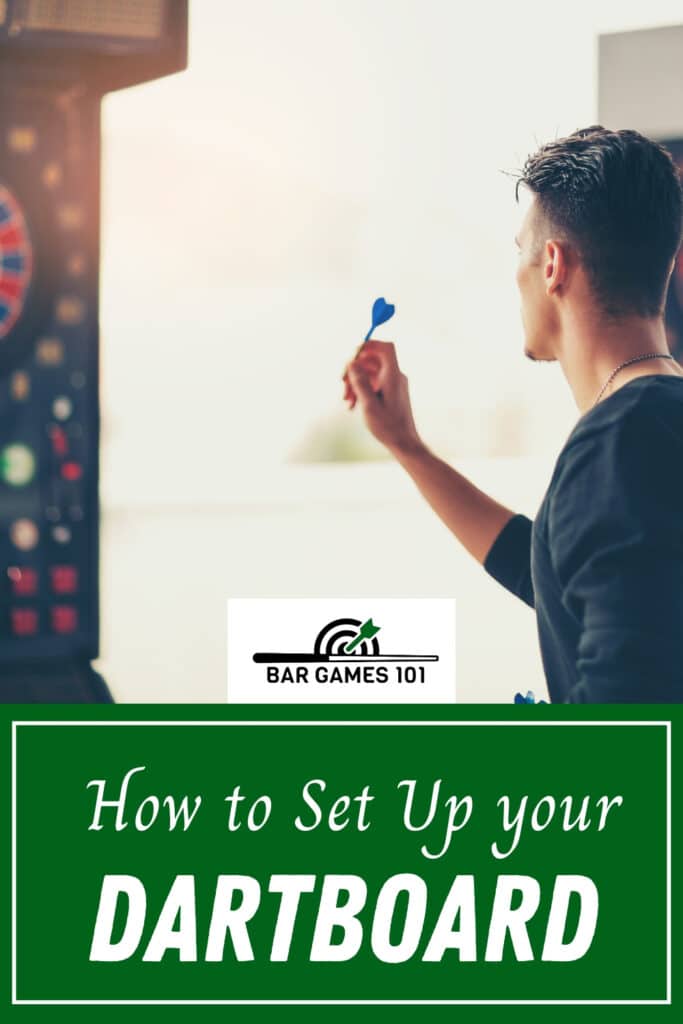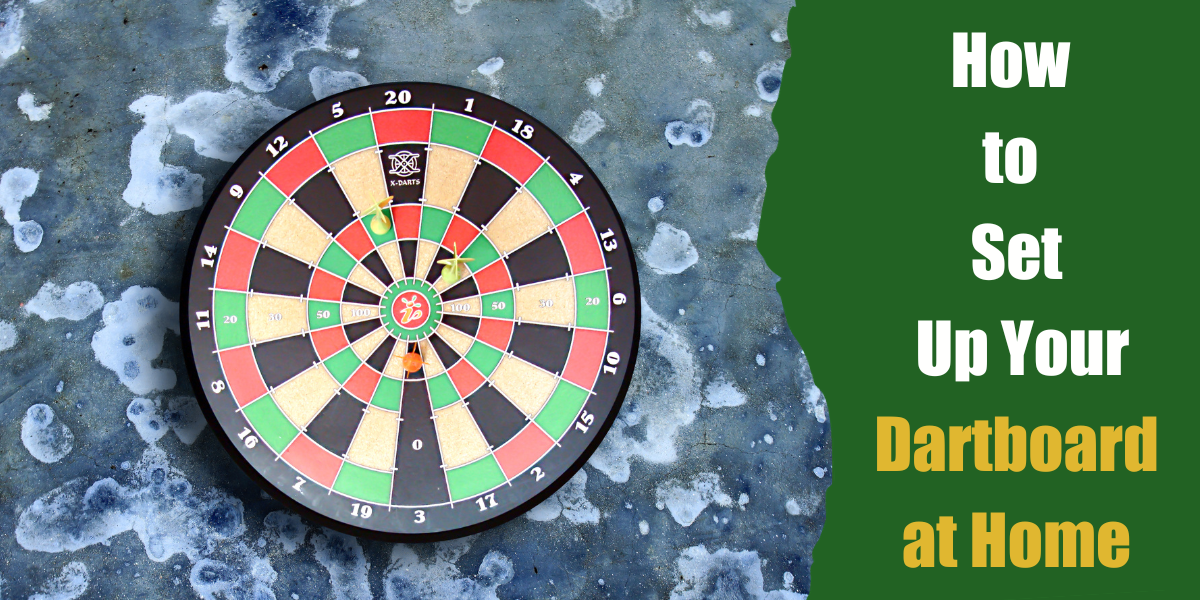Your dartboard setup should be an area of your house or apartment where you can throw darts in a safe and comfortable environment.
A place where you can practice and play countless hours of your favorite dart games with your friends.
Luckily, setting up your own dartboard and creating an optimal darting space isn’t that difficult, expensive or time-consuming.
In this post I’ll cover everything you need to know to have the best dartboard setup, including official dartboard measurements, mounting options, basic lighting advice, flooring and safety considerations.
Let’s get started.
What are Official Dartboard Hanging Measurements?
First thing’s first: before you start planning your wall decorations or custom dartboard surround, you need to know the correct dartboard hanging measurements.
You should pick an area with plenty of space to allow for these measurements, plus some extra space to create a safe and comfortable darting environment.
What Height Should the Dartboard Be?
The height from the floor to the center of the dartboard (the bulls eye) must be 5 feet 8 inches (1.73 meters).
This is the internationally recognized official dartboard height for steel tip as well as soft tipped darts.
As you’ll see, I recommend mounting the board at the correct height before measuring out to the throwing line (more details about how to mount the dartboard below).
How Far Should the Throwing Line Be?
The official distance to the throwing line is 7 feet 9 ¼ inches (2.37 meters) from the face of the dartboard.
Note: The distance is not measured from the wall.
A standard 18″ dartboard is approximately 1 ½” thick.
If you also know the thickness of your backing surface, you could easily estimate where to measure the throwing line distance from.
But it’s much easier to mount the dartboard at the correct height first.
Once the dartboard is mounted at the correct height, you can drop a plumb line or string from the center of the bulls eye to the floor.
From that point, you would measure 7′ 9 ¼” to the front of the throwing line. This measurement would need to be 8 feet for soft tipped darts (i.e. for an electronic dartboard).
Best Laser Toe Line Marker
Diagonal Distance to the Throwing Line
Another way to determine the throwing line distance from the face of the dartboard is to take a diagonal measurement. But find someone to help first.
Have that person hold a tape measure at the center of the double bulls eye and measure out diagonally to 9 feet 7 ⅜ inches (2.37 meters).
If you don’t have someone to help you, using the horizontal approach with the correct measurements should yield the same results.
Dartboard Setup: How to Mount Your Dart Board
A dartboard should be mounted flush against a backing surface. The backing surface is optional but highly recommended versus mounting the board directly on a wall.
I’ll discuss options for backing surfaces in more detail below.
If you do mount directly on your wall, make sure you’re mounting into wood or concrete.
Some people use heavy duty anchor screws to mount into drywall. I don’t recommend doing this.
A high quality bristle dartboard is at least 10 lbs.
This weight combined with the force of pulling darts from the board on a regular basis makes using anchors in a dry wall seem pretty risky.
If you do use anchors, make sure they are heavy duty metal hangers with significant weight capacity.
Hanging the Dartboard with a U-Shaped Metal Bracket
Dartboards usually come with a basic metal hanger kit.
This includes a center screw, U-shaped hanging bracket, and three spring clips for leveling the dartboard against the wall or backing surface.
The center screw is screwed directly into the back of the dartboard at dead center.
The spring clips should then be spaced out and installed to the back of the dartboard.
There’s no exact location for the spring clips. Just spread them out evenly on the back of the dartboard. A triangular formation works well.
The U-bracket is then screwed into the wall or backing surface.
The bracket should be measured out so the bottom of the U-slot sits at 5 feet 8 inches high. That is where the screw on the back of the board will sit.
We want to make sure that the center of the dartboard is at this exact height.
You then simply slide the board with the screw fitting into the U shaped slot. It should fit snugly against the backing surface with minimal if any movement.
If there is more than a little movement, try to tighten the center screw on the board and then slide it back into the bracket.
Tightening the screw the right amount should prevent the board from moving or spinning.
Here’s a simple demonstration of mounting with basic metal handing brackets.
Disc Mount Hanging Kits
Another option for mounting your dartboard is the disc mount hanging kit.
These kits include two thin but sturdy mounting pieces: the disc, which is screwed into the center back of the dartboard, and a wider U shaped bracket that is screwed into the backing surface or wall.
With a disc style mounting kit, you do not have to worry about using spring clips.
The width of the disc and bracket keeps the board flush, level and secure.
Users of these brackets report that it’s easier to center the board as well.
If you have an older dartboard setup in need of a replacement hanging kit, it may be worth an upgrade to one of these.
The U-shaped bracket has a screw hole that should be measured to the correct height of 5 feet 8 inches.
Here’s a demonstration of mounting a dartboard with a disc bracket.
Dartboard Backing Surfaces and Cabinets
A lot of darts enthusiasts opt for a dartboard cabinet as an all-in-one solution.
Cabinets can be made from a variety of materials.
But traditional dartboard cabinets are usually made of high quality wood, such as solid oak or rose wood, and can be beautiful as well as functional decorative pieces.
The dart holders and scoreboard are mounted on the side doors. Certain cabinets also come with built-in lighting. And some of the newer dartboard cabinets even have electronic or LCD displays for score keeping.
Further Reading: Learn more about essential dartboard accessories.
Custom or DIY Backing Surfaces
Commonly used backing surfaces, also known as “surrounds”, include carpeting, cork or plywood covered in dark fabric.
As you’ll see from the pictures below, you can get pretty creative with choosing a functional and decorative backing surface material for your dartboard setup, such as wine corks, pallets, or reclaimed wood.
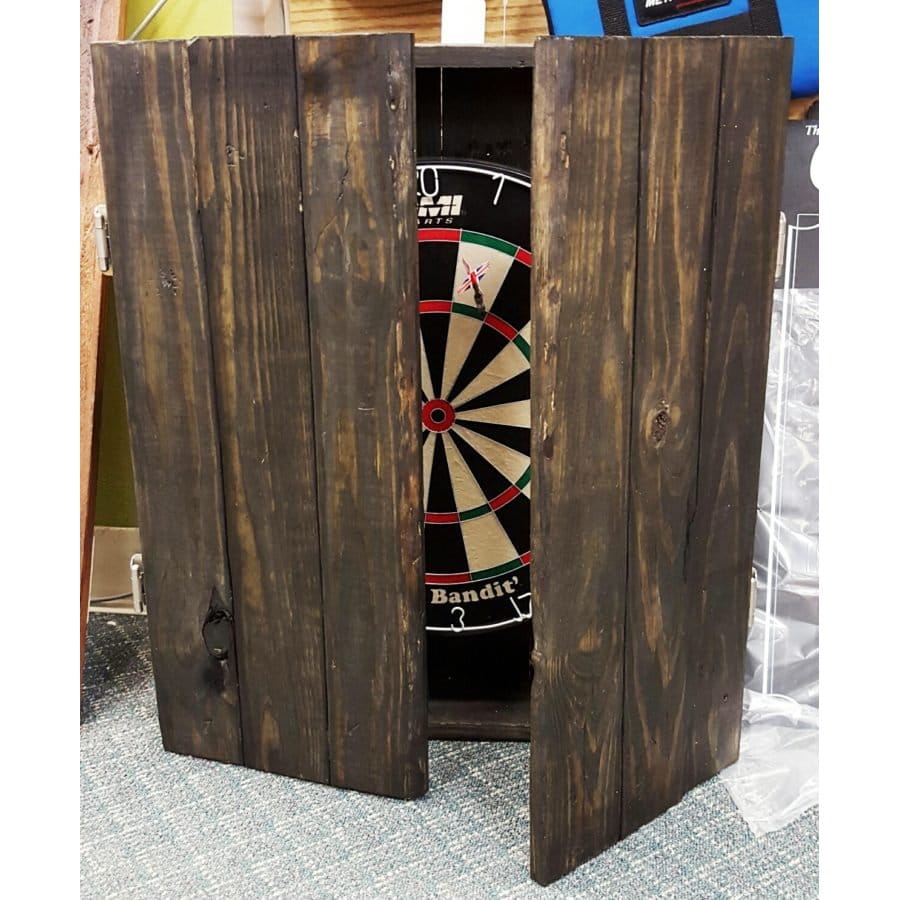
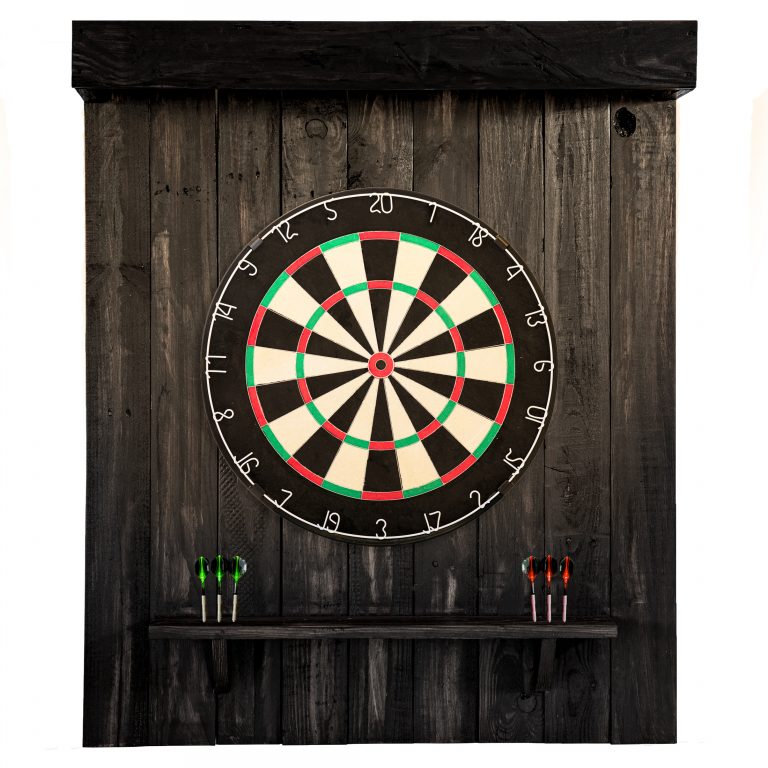
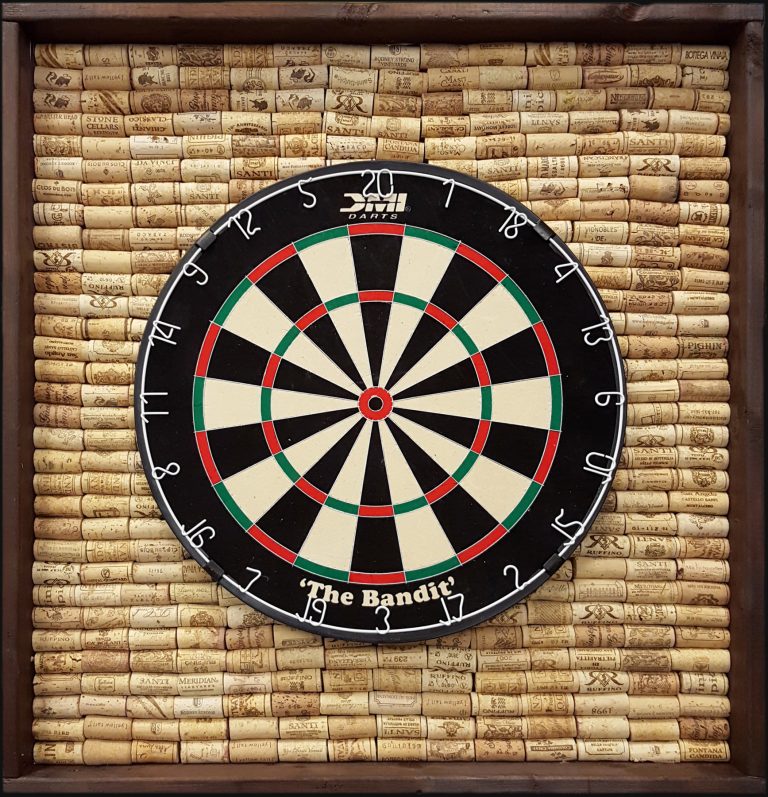
Images: Hand Crafted Dartboard Cabinets Made from Reclaimed Materials by Royal Billiards
When selecting the backing surface, consider that the diameter of the board itself is about 18 inches.
So, your backing surface should be at least 3 square feet to allow room for the board and scoreboard, plus extra room for wayward darts.
You also need enough thickness for hanging the mounting bracket.
If you’re using plywood and are worried about the thickness, a common solution is to secure some cork board over the plywood. This provides added thickness and extra protection for your dart tips.
You can also use a thick piece of corrugated cardboard for this.
The scoreboard can be either a basic chalk board or dry erase board.
In either case, dart specific scoreboards will come printed with target numbers and scoring columns for Cricket, and additional columns for 01 games.
Marking the Throwing Line (aka Oche)
In darts, the player must stand behind a clearly marked line when throwing his or her dart. This is also known as the oche (pronounced like ‘hockey’) or toe line.
We’ve already marked the toe line at the correct distance from the dartboard.
Now we just need to make the line official.
For most of us, a wide strip of tape will do just fine.
You can use duct tape or something else that’s durable enough to withstand foot traffic and will adhere to your floor surface.
Lay the strip with the front edge across the throwing line mark.
This way you can still stand on the strip when throwing, but your front toe should stay behind the front edge of the tape strip. Hence the term “toe line”.
Many bars and darts establishments like to use a thin strip of wood as their oche. The wood is secured to the floor and raised approximately 1 ½ inches high.
The throwing player stands behind this line, often with the leading toe lightly pressed against the wood strip.
If you purchase a rubber or vinyl mat for your dartboard setup, it will most likely have the lines already marked for both steel and soft tipped throwing distances.
What Type of Floor Surface is Best for Darts?
The floor between the throwing line and the dartboard can take a beating.
If you have nice hardwoods, definitely consider putting down a mat that’s thick enough to withstand steel dart tips.
Laying down a protective surface is also a good idea if you have concrete floors or a different hard surface that could damage your dart tips.
The best option for for your dartboard setup is a rubber or vinyl dart mat.
These mats are made to protect your dart tips and the floor beneath.
Dart mats are typically about 1/4 inch thick, 30″ wide and 10 feet long.
They are made to fit within your dartboard throwing area and come printed with pre-measured toe lines for both steel and soft tipped dart distances.
If your dartboard is setup in an open space, using a rubber dart mat is also an easy way to visually separate the throwing area from other parts of the room.
When you’re finished, you can just roll up the mat and store it away. Your dartboard remains in place as a beautiful wall decoration until the next game.
Of course, you can also just use an inexpensive rug or another soft but durable material to provide a protective flooring layer.
Or if the room is already carpeted, as in a finished basement, you may not need to add anything.
Lighting For Your Dartboard Setup
Your dartboard setup is not complete without adequate lighting.
You do not need an elaborate lighting setup though.
Many bars use a simple spotlight mounted above the dartboard.
The light(s) can be mounted on the ceiling directly above the dartboard or slightly away from the board, angled back and shining directly on the face of the dartboard.
If mounting away from the dartboard, make sure there is plenty of space and clearance from the dart thrower’s arc.
The wattage for a single spotlight should be high enough to cover the entire board. If the lighting is not sufficient, it will create shadows on the dartboard.
As mentioned, many dartboard cabinets come with the lighting built in.
A simple overhead track light will also work well. The goal is to angle the lights so there is no shadow near the dartboard.
Of course, you also want to make sure there are no lights shining in the thrower’s eyes or creating a distraction in any way.
Many homeowners use a basic three light mount on the ceiling to illuminate their dartboard setup.
The idea is that the lights can be angled in away to overlap and create a “cross lighting” effect, thereby minimizing any shadows from the individual directional lights.
What About Safety Considerations?
There are some basic safety aspects that you should consider when creating your dartboard setup.
First, there should obviously be plenty of room so participants and guests can stay clear of thrown darts.
No products found.
Don’t set your dartboard up in a cramped area where there’s no room to stand except in harm’s way.
Darts can easily bounce off the board and pose a threat even if you’re a few feet away.
Next, make sure there are no breakable objects near the dartboard. This includes windows, TV screens, glassware, etc.
Also, do not set the board up in an area near an active doorway, hallway or other part of the room where someone could accidentally walk in while you’re throwing darts.
And make sure young children and pets are out of danger. They should always remain well behind the throwing area.
Finally, keep your darts in a safe place that is well out of reach of small children.
—
I wish you the best of luck with setting up you ideal dart space. It’s a great way to practice, improve and introduce others to the game.
If you have any other suggestions or questions about how to set up a dartboard, please let me know!
